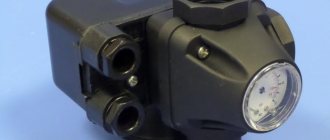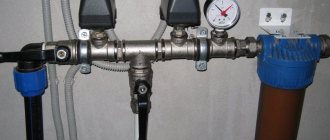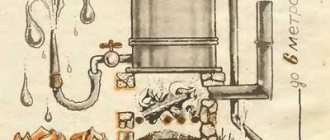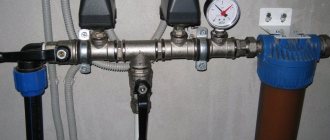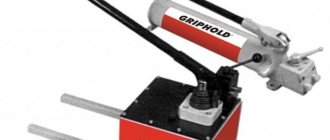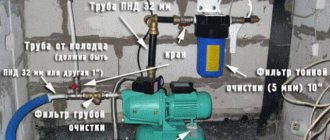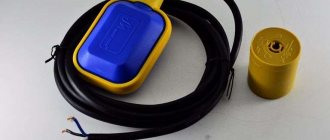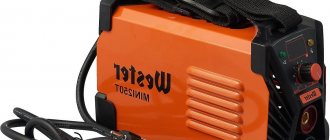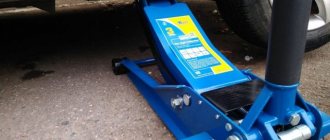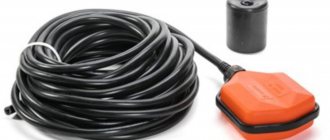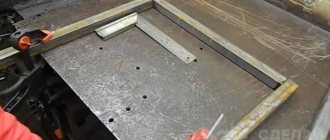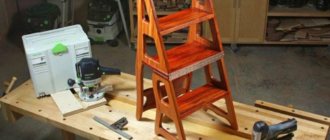What is dry running of a pump?
The pump must draw water from somewhere. Most often, a well is made or a well is dug for this purpose. A situation may arise where water stops flowing.
For example, the life of the well has expired or the weather is hot, underground moisture in the well does not have time to accumulate.
In this case, if the pump does not turn off, the so-called dry running occurs. Some call it "single", but this term is not entirely applicable to this situation.
- This situation is fraught not only with the fact that electricity is wasted.
- Water is also needed to cool the device. If it does not flow, the pump overheats and breaks down.
- Now the market sells both devices with built-in automatic protection and those without it.
You can purchase additional automation at any time. And it is better to do this as soon as the pump is purchased. In addition, purchasing everything separately will be much cheaper.
Advantages and disadvantages
The Wilo brand has established itself as a system with European quality and high-level warranty service. Among the advantages are noted:
- No dependence on power surges thanks to a multi-stage motor and rotor protection system.
- Easy installation and connection to the pipeline.
- No noise during operation or low noise level.
- Some models have built-in cold protection.
- Use of corrosion-resistant materials for the main mechanisms.
- The ability to manually or automatically adjust the pressure, switch power and change the shaft speed.
- Economical power consumption and durability of the station.
The Vilo pumping installation does not cause any difficulties for users during operation.
Among the disadvantages are the following nuances:
- Low level of efficiency in a circulation station with a wet rotor and when pumping out binders.
- Centrifugal pumps must be primed before starting.
- A dry rotor system may make some noise during operation.
Causes of dry running
The most common cause of pump failure is dry running. And this will not be a warranty case, that is, the money spent will not be returned. Because both the manufacturer and the seller always warn about this.
If this happens, it is entirely the fault of the owner, who improperly operated the device. There may be several reasons for this situation:
- The depth was selected incorrectly during installation. As a rule, it is calculated individually and depends on how deep the well or well is. The fluid level will constantly change as it is consumed. And as soon as it reaches the place where the unit was placed, it will stop swinging, because there will be nothing left to pump. It will overheat and break;
- The pump successfully pumps water, but it runs out. This may well be because moisture, like any other resource, must be given time to recover. That is why sometimes the device is turned off manually until the water is restored to the required volume;
- If you have a surface installation, its seal may become compromised over time. Then air begins to be sucked in along with the water, which is where the breakdown occurs after some time.
There are not many reasons, but each of them deserves attention, because otherwise the money will be wasted.
Reviews from station owners
Users of pumping stations note their reliability, uninterrupted operation and ease of use. The reviews are mostly positive:
- Mikhail, Samara: “I purchased the MC 305 EM pumping station 2 years ago. I was choosing between it and the Redrollo brand. I settled on Wilo because the manufacturer provides a 2-year warranty. During the work she showed herself to be excellent. True, there were problems with the engine, I had to take it to a service center. I was pleased with the free replacement."
- Dmitry, Moscow: “I took the Vilo station for a well. It works properly, the price is normal and the quality is good. I wouldn't call it quiet, my wife and I can hear it buzzing in the basement. The model was chosen from the Jet line with a 20 liter tank. The best option for a small family, I recommend it.”
- Valeria Arkadievna, Kazan: “If you don’t need a large pumping station power, then I advise you to buy Wilo. The soft movement won us over; at first we ran around and checked whether it worked. No problems or failures were noticed during the summer season; water is pumped daily. We chose model 203 with a power of 0.75 kW. For a summer cottage, this is a completely acceptable option.”
Source: https://watersyst.goldroofas.ru/osobennosti-nasosnyx-stancij-wilo.html
How to protect against dry running
To do this, you can purchase several devices, the installation of which will protect against premature repair or replacement:
- Protective relay;
- Installation of liquid flow control;
- Level sensors.
As soon as the water stops flowing, these devices immediately turn off the pump. They each work differently, but they perform the same function. All that remains is to choose the appropriate option for yourself, which seems most effective.
There are also a few tips for installing your equipment to help protect it:
- The installation must be carried out in a warm room that can be heated during the cold season;
- It is necessary to install sound insulation if you plan to place the pump in the house itself;
- It is better to install the remote unit next to the well;
- Monitor your blood pressure levels. To avoid losses, place the station next to the collector.
These tips and a few additional devices will help extend the life of the installation and avoid problems with its breakdown.
Pump dry running protection relay
A simple device that monitors blood pressure levels. As soon as it drops below normal, the automation is activated and turns off the pump. The membrane that is included in the relay device helps to do this.
Under normal conditions, the contact group is open. As soon as the pressure drops, the membrane begins to act on the contacts, they close, and the equipment turns off.
- Usually it is placed on the surface. You can also purchase a sealed model, but it will cost more.
- Works well in any system where a hydraulic accumulator is not provided.
- It is better to purchase for surface pumps; in such systems the relay shows itself most effectively.
- But in installations with a hydraulic accumulator, maximum protection may not be obtained, because the relay may not always work perfectly.
Due to the design of such systems, when liquid can remain in the battery itself, the protection system may behave incorrectly, which is why the risk of breakdown is very high.
You can notice in time that the system is unstable, but there are situations when you notice it too late. Therefore, a relay will not work, but there are other devices.
Flow control equipment
In this case, you can install both controllers, which are electronic, and electromechanical sensors that will monitor the flow of water. Sensors, in turn, are divided into petal and turbine.
The first type is very simple, it is installed directly into the pipeline. At the same time, its petals will deviate, close the contacts, and a shutdown will occur.
Turbines are designed as a turbine that rotates and generates an electromagnetic field. It already affects the sensor itself, which looks at incoming pulses and, depending on this, turns the equipment on or off, thus providing protection.
- The controllers not only protect against dry running, but also monitor pressure.
- They can also be equipped with additional functions, for example, including a pressure gauge.
- They will cost more, but the system will be under reliable protection.
When installing the controller, remember that increased pressure may occur in the system, which will lead to rapid wear. Therefore, sometimes they install both a controller and a hydraulic accumulator. This will allow you to adjust the pressure.
Specifics of operation
Pumped water in home systems involves several parallel processes:
- transportation of liquid to the consumer;
- cooling of pumping equipment;
- lubrication of elastic pump elements
The negative consequences of improper operation are especially noticeable in vibration equipment, which is the most popular in domestic water supply systems. The phenomenon is also considered unacceptable for submersible, surface and drainage devices.
If there is no protection against dry running of the well pump, then the following will occur:
- moving elements heat up and increase the temperature of adjacent units;
- most parts are subject to deformation;
- in a certain situation, jamming occurs, which leads to failure of the electrical part.
In the design of the pumping station, it is necessary to install protection in a timely manner, since the consequences of “dry running” cannot be repaired under warranty; the work will have to be carried out at your own expense.
When checking the condition of failed equipment, it will not be difficult for a specialist to determine the cause of this condition. This is evidenced by characteristic deformation signs of structural elements. In the instructions for the equipment, the manufacturer clearly states that it is inadmissible to operate pumps without liquid poured into the working cavities.
Alleged “culprits” of the breakdown
There are several most common reasons that lead to extreme pump operation:
- Unbalanced pump power. In such a situation, liquid is quickly pumped out due to insufficient flow of the well or for pumps whose intake part is located above the dynamic level.
- The connection diagram has a section of the intake pipe in which there is depressurization. Air will flow in through the hole.
- The pumping pipe is clogged, which often happens with surface pump models.
- Hydraulics operate at reduced pressure.
- When pumping liquid from any container, it is necessary to prevent air entrapment.
Without installed automatic systems, it will be quite problematic to cope with preventing “dry running”.
VIDEO: Disassembly, inspection and cleaning of the Aquarius deep-well pump
Types of hydraulic system protection
One of the main factors in obtaining a reliable circuit is the installation of automation. Such equipment includes the following components:
- dry running sensor for pump;
- dry running relay for stations or pumps;
- pressure switch;
- float switch.
Float switch off
One of the universal blockers is a dry-running float sensor for a submersible pump. This chain element is a relatively inexpensive aid for protecting hydraulic equipment. Thanks to the ease of installation, this dry-running sensor for a pump is used in many schemes, for example, when pumping is carried out from classic wells or some containers.
The dry running sensor for the submersible pump is connected to the electrical circuit for one of the power phases. A special contact inside the device will break the connection at a certain position of the float body. This way the pumping will stop in a timely manner. The actuation height is set when setting where the float is installed. The cable that connects the dry running sensor for the pump is installed at a certain level so that when the float is lowered, absolutely complete fluid withdrawal does not occur. A certain amount of liquid must remain when the contacts open.
When water is withdrawn by surface or submersible units, the sensor is mounted so that even after the contact is broken, the liquid level is still above the intake grid or valve.
The disadvantage of the float is its zero versatility - you cannot install it in a narrow shaft.
In such a situation, it is necessary to look for other methods that will protect against dry running of the well pump.
Water pressure switch
The dry-running protection relay used is structurally electric, which makes it possible to break the contact in the circuit when the pressure and, accordingly, the water level in the source critically drop. The initial minimum value is set by the manufacturer. Usually it varies in the range of 0.5-0.7 atmospheres.
Pressure switch against dry running
The vast majority of dry-running relay models for domestic needs do not provide for independent adjustment of the threshold value.
Under normal operating conditions of a pumping station, the pressure in the system always exceeds one atmosphere. An underestimation of the indicator indicates only one thing - air has penetrated into the intake pipe. The automation immediately breaks the contact that powers the pump, preventing current from flowing through the cable. Starting after a break is carried out exclusively in manual mode, which is additional protection.
The use of such a relay makes sense if certain conditions are met:
- the presence of a closed water supply circuit;
- mounted hydraulic tank;
- use of a pumping station with a surface or submersible pump.
The operating principle of this relay is relevant for systems with deep pumps.
Water flow sensor
The circuits use special dry-running sensors that record the speed of water flowing through the pump. The design of the sensor includes a valve (petal) located in the flow section and a reed switch microswitch. There is a magnet on one side of the spring-loaded valve.
The algorithm by which this sensor works is as follows:
- water pushes the valve;
- due to the push, the spring is compressed;
- the contacts close and the equipment begins to work.
As soon as the flow weakens or ends completely, the pressure on the valve stops, accordingly, the spring weakens, the magnet moves away from the switch and the contact breaks. The pump stops working. When water appears, the entire cycle is repeated automatically.
This sensor is built into low-power hydraulic equipment. Its work is to balance between two quantities: flow and pressure level. Positive qualities are the following characteristics:
- compact dimensions;
- ease of installation;
- speed of response to shutdown.
Thanks to the high response speed, it is possible to turn off the power in a timely manner, which reduces the risk of waterless operation.
VIDEO: What type of automation should I choose for the pump?
If it is necessary to install universal protection, experts recommend using a mini AKN device for emergency modes. It is based on electronic protection of self-priming equipment, which responds to specified parameters.
The advantages of the device are:
- minimal energy consumption;
- small parameters;
- comprehensive protection against extreme conditions;
- high degree of reliability;
- ease of installation.
Operation without installed protection
In certain cases, you can do without installing additional protective units. This is possible in the following situations:
- liquid is taken from a source that constantly contains water;
- direct visual monitoring of the liquid level is carried out;
- high flow rate in the well.
If you hear that the unit begins to stop, or rather “choke,” you must independently disconnect it from the network. It is not recommended to restart the hydraulics without checking.
VIDEO: Electrical diagram for connecting an automatic deep-well pump
views
Pump water level sensors
You can install a float or electronic sensor. They are usually used if the pump is submersible, although they work quite effectively with surface models.
The simple operation of a floater is that it works as long as the float is in the upward position.
As soon as the water level changes, the float also changes its position, the automation is activated and the pump is turned off.
- Electronic ones work not only to reduce the water level, but also to increase it.
- They are also useful for use in swimming pools when water is supplied to it.
- They consist of two electrodes, one is set to minimum, and the second is slightly lower.
- As long as the water is at the optimal level, currents flow between them.
As soon as the level becomes critical, the current stops flowing, the circuit breaks, and a signal of water shortage is received. The pump immediately turns off.
Price
| Name | power, kWt | Number of pumps | Diaphragm tank, l | Price, rubles |
| Economy MHI 202 | 0,55 | 2-4 | 8 | 96 070 |
| Economy MHI 406 | 1,6 | 2-4 | 8 | 101 790 |
| Jet HWJ 201 EM | 0,55 | 1 | 20 | 6 500 |
| Jet HWJ 401 EM | 1,3 | 1 | 60 | 16 100 |
| MultiCargo FMC 304 EM | 0,55 | 1 | — | 19 055 |
| MultiCargo FMC 605 EM | 1,5 | 1 | — | 24 595 |
| PW-175EA | 0,35 | 1 | 0,2 | 4 750 |
| SilentMaster 303 | 0,55 | 1 | 50 | 42 600 |
| SilentMaster 305 | 0,75 | 1 | 50 | 49 800 |
